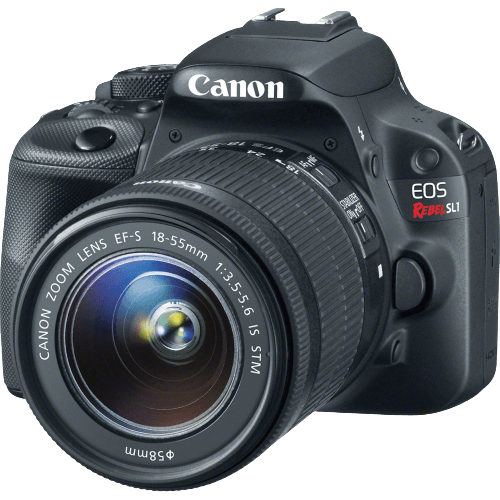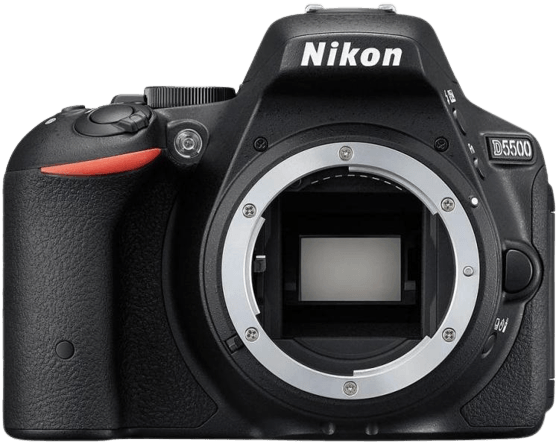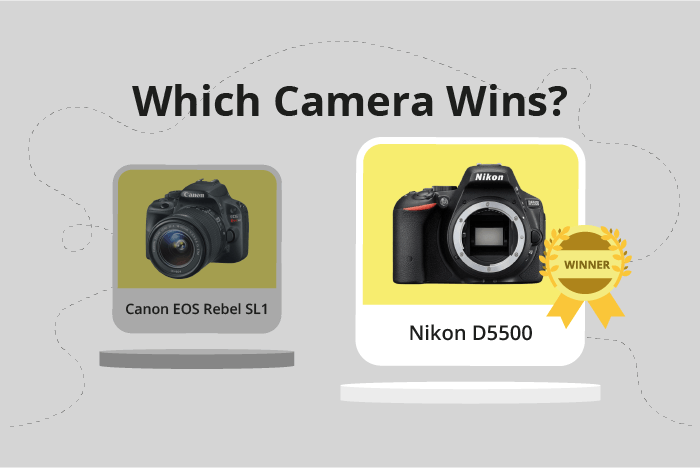Canon EOS Rebel SL1 / 100D vs Nikon D5500 Comparison
Canon EOS Rebel SL1 / 100D

Nikon D5500

The Nikon D5500 comes out on top with a score of 61/100, outperforming the Canon EOS Rebel SL1 / 100D, which scored 43/100. Both cameras are DSLRs released in 2013 and 2015, respectively. They share similar dimensions, with the Nikon D5500 measuring 124 x 97 x 70mm and weighing 420g, while the Canon EOS Rebel SL1 / 100D is slightly smaller and lighter at 117 x 91 x 69mm and 407g.
The Nikon D5500 justifies its higher score with a better overall performance and more advanced features. However, the Canon EOS Rebel SL1 / 100D still has some advantages, such as its lower launch price of $650 compared to the Nikon’s $900.
Taking all factors into consideration, the Nikon D5500 proves to be the superior camera, but the Canon EOS Rebel SL1 / 100D remains a viable option for those seeking a more budget-friendly choice.
Canon EOS Rebel SL1 / 100D vs Nikon D5500 Overview and Optics
The Nikon D5500 takes the lead in optics, scoring 65/100, while the Canon EOS Rebel SL1 / 100D scores 40/100. Both cameras share common specifications, such as an APS-C sensor size, CMOS sensor type, and no image stabilization. They also have their respective lens mounts, with the Canon using an EF-S mount and the Nikon utilizing an F DX mount.
The Nikon D5500 outperforms the Canon SL1 / 100D in several aspects. With 24.2 megapixels, the D5500 has a higher resolution than the SL1 / 100D’s 18 megapixels, which allows for more detailed and sharper images. Additionally, the D5500 has a faster shooting speed of 5 frames per second (fps), compared to the SL1 / 100D’s 4 fps, making it better for capturing fast-moving subjects. The D5500’s Expeed 4 processor is more advanced than the SL1 / 100D’s Digic 5 processor, which contributes to its superior performance. The D5500 also boasts a higher DXOMARK sensor score of 84, compared to the SL1 / 100D’s score of 63, indicating better overall image quality.
The Canon SL1 / 100D, despite its lower score, has some advantages over the Nikon D5500. Its compact size and lightweight design make it more portable and convenient for travel or everyday use. However, this advantage does not outweigh the superior optical performance of the Nikon D5500.
Taking these factors into account, the Nikon D5500 emerges as the better option for those seeking superior optical performance. The higher resolution, faster shooting speed, more advanced processor, and better DXOMARK sensor score all contribute to its lead over the Canon SL1 / 100D. While the Canon SL1 / 100D offers portability, it falls short in delivering the same level of image quality and performance as the Nikon D5500.
Canon EOS Rebel SL1 / 100D vs Nikon D5500 Video Performance
The Nikon D5500 emerges as the winner in video capabilities, scoring 70 out of 100, while the Canon EOS Rebel SL1 / 100D scores 43 out of 100. This 27-point difference highlights the superiority of the Nikon D5500 in terms of video performance.
Both cameras share some common video specifications, such as Full HD maximum video resolution and maximum video dimensions of 1920 x 1080. However, the Nikon D5500 outperforms the Canon EOS Rebel SL1 / 100D in several aspects. The most notable advantage of the Nikon D5500 is its higher maximum video frame rate of 60fps, compared to the Canon’s 30fps. This allows for smoother and more professional-looking videos. In addition, the Nikon D5500 has a built-in time-lapse functionality, which the Canon EOS Rebel SL1 / 100D lacks. This feature enables users to create stunning time-lapse videos without needing additional equipment or software.
On the other hand, the Canon EOS Rebel SL1 / 100D does not offer any significant advantages in video capabilities over the Nikon D5500. Its lower video score and the absence of built-in time-lapse functionality make it less appealing for videographers.
Taking these factors into account, the Nikon D5500 is the clear winner when it comes to video capabilities. Its higher video frame rate and built-in time-lapse functionality make it a superior choice for those looking to capture high-quality videos. On the other hand, the Canon EOS Rebel SL1 / 100D falls short in this area, making it less suitable for users who prioritize video performance.
Canon EOS Rebel SL1 / 100D vs Nikon D5500 Features and Benefits
The Nikon D5500 emerges as the winner in this comparison, scoring 59/100 in features, while the Canon EOS Rebel SL1 / 100D scores 57/100. Both cameras share some specifications, such as a 3-inch (Canon) and 3.2-inch (Nikon) screen size, touchscreen capabilities, and the absence of GPS and Bluetooth.
The Nikon D5500 outperforms the Canon EOS Rebel SL1 / 100D with its flip screen and Wi-Fi connectivity. The flip screen allows for versatile shooting angles and is useful for vlogging or capturing images from challenging perspectives. Wi-Fi connectivity enables easy sharing and transfer of images to other devices, which is a significant advantage for photographers who need to quickly share their work.
On the other hand, the Canon EOS Rebel SL1 / 100D has a slightly higher screen resolution (1,040,000 dots) compared to the Nikon D5500 (1,037,000 dots). This difference is minimal and may not impact the overall user experience significantly.
In conclusion, the Nikon D5500 is the better camera in terms of features, mainly due to its flip screen and Wi-Fi capabilities. The Canon EOS Rebel SL1 / 100D has a marginally higher screen resolution but lacks the additional features that give the Nikon D5500 an edge. Therefore, the Nikon D5500 is the recommended choice for those seeking a camera with more advanced features.
Canon EOS Rebel SL1 / 100D vs Nikon D5500 Storage and Battery
The Nikon D5500 outperforms the Canon EOS Rebel SL1 / 100D in the storage and battery category, scoring 35/100 compared to the Canon’s 21/100. Both cameras have a single memory card slot and accept SD, SDHC, and SDXC cards. Neither camera offers USB charging.
The Nikon D5500’s battery life is significantly better, providing 820 shots per charge, while the Canon EOS Rebel SL1 / 100D only offers 380 shots. The Nikon uses an EN-EL14 battery, while the Canon uses an LP-E12 battery.
Despite the lower score, the Canon EOS Rebel SL1 / 100D does not have any specific advantages in storage and battery over the Nikon D5500. The Nikon D5500’s superior battery life makes it a more reliable choice for extended shooting sessions.
Canon EOS Rebel SL1 / 100D vs Nikon D5500 – Our Verdict
Are you still undecided about which camera is right for you? Have a look at these popular comparisons that feature the Canon EOS Rebel SL1 / 100D or the Nikon D5500:

